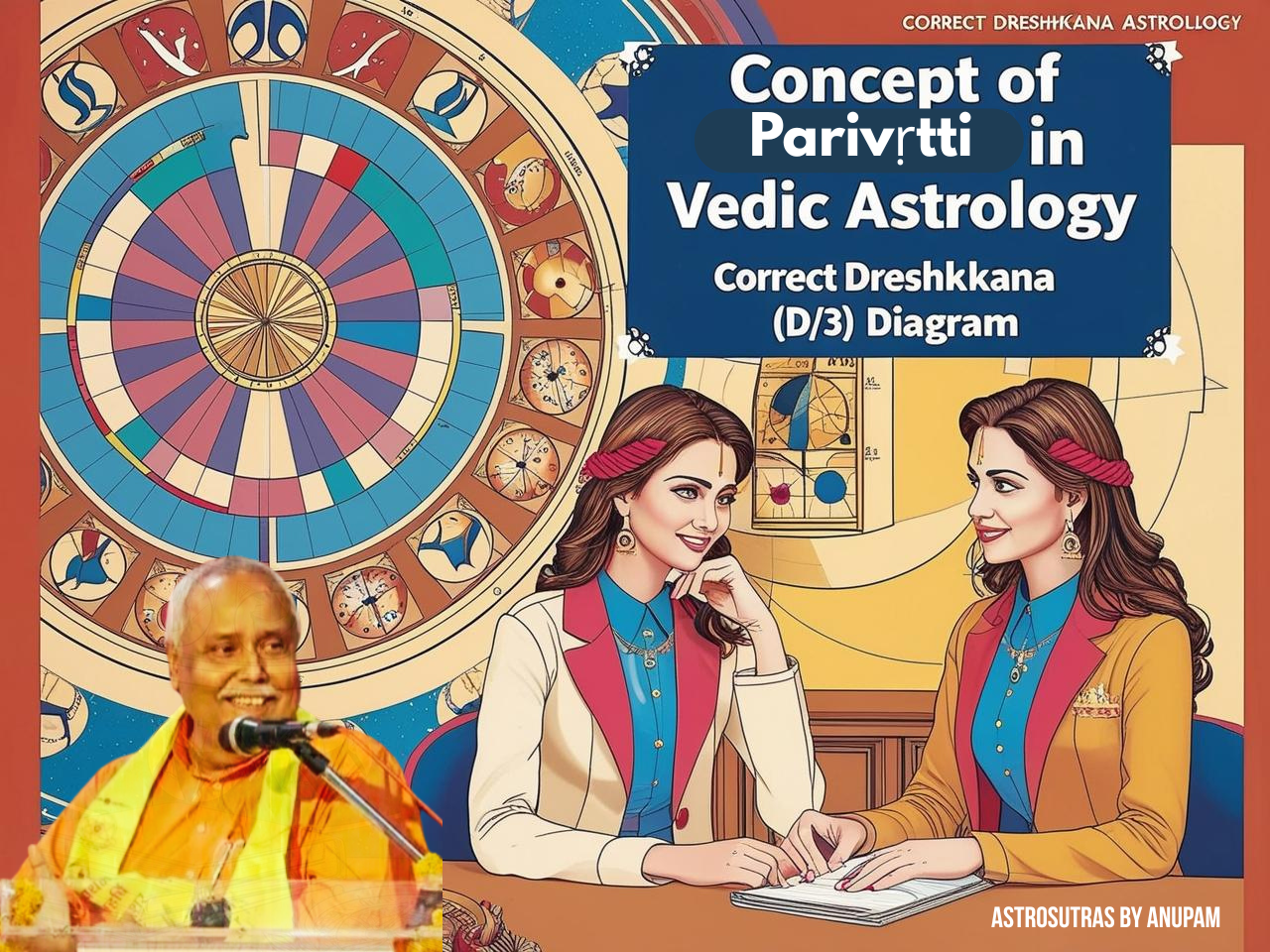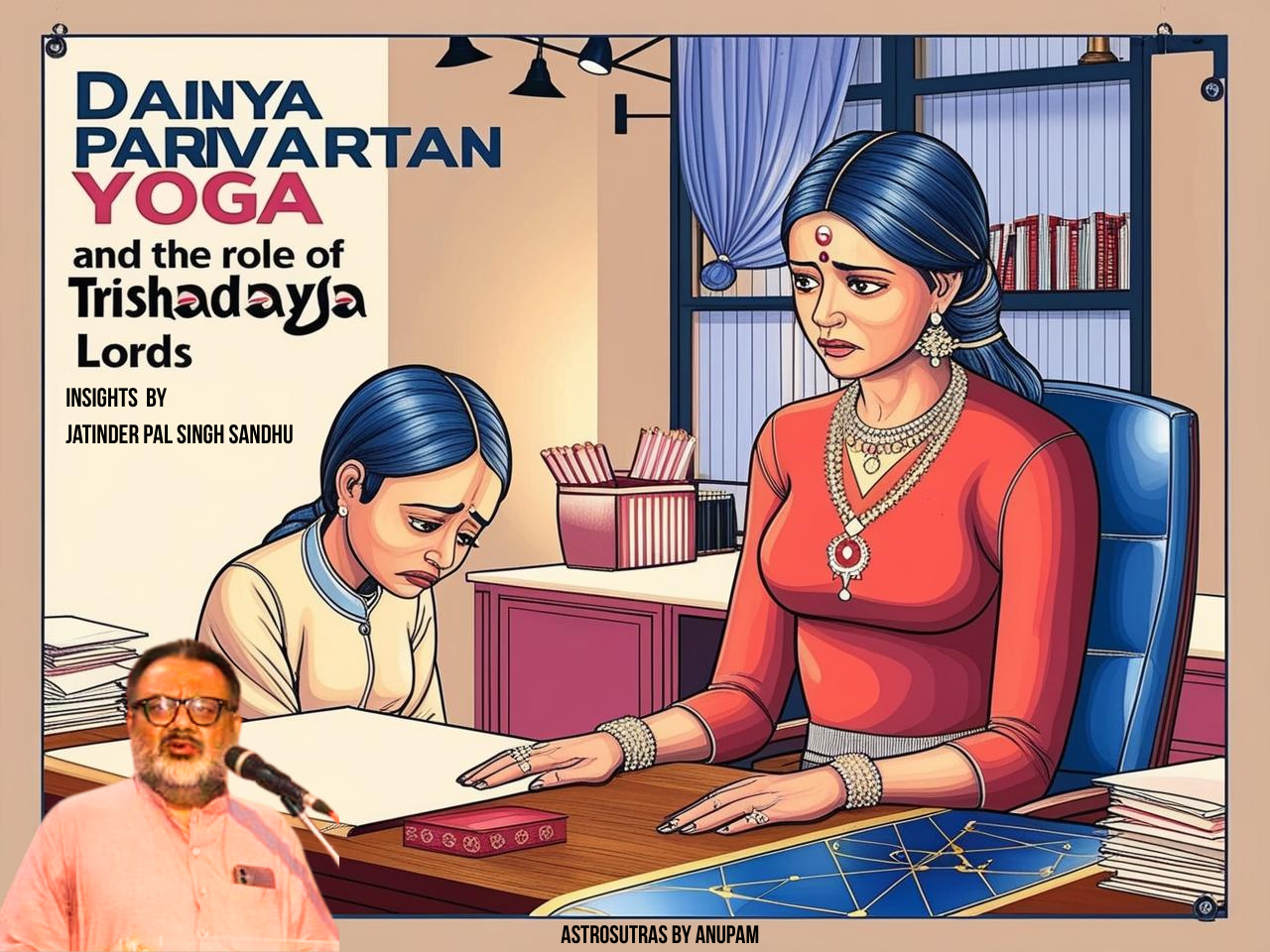Concept of Parivriti in Vaidik Astrology and the Correct Dreshkana (D/3) Diagram

In the realm of human psychology, it is often observed that once we learn something new, we tend to believe we have understood all there is to know about that subject. Rarely do we pause to appreciate the vastness and depth that truly exists within any discipline. This tendency is particularly noticeable among students of Vaidik Astrology. Even those among our well-respected friends are not immune to this subtle but serious shortcoming of human nature.
From time to time, I endeavor to highlight critical areas where students, despite their confidence, are prone to making mistakes. This article is one such effort—meant as an eye-opener for many sincere learners.
In the Brihat Parashara Hora Shastra (BPHS), the term Parivriti appears primarily in relation to two divisions: Hora and Dreshkana. This fact alone is sufficient to indicate that Parivriti is an inseparable attribute of all Varga diagrams in Vaidik Astrology. It was Pt. R. Y. Ojha who first drew attention to the flaws in the available divisional charts, pointing out that the speculums presented by commentators lacked proper Parivriti. Following him, Pt. G. K. Ojha attempted to present corrected charts based on Parivriti principles in his books. Later, many others—including Pt. A. D. Pathak, O. P. Paliwal, myself, and several distinguished astrologers—continued work in this direction.
In this write-up, we shall specifically address the Dreshkana (D/3) chart, both in terms of discussion and illustration.
The Conventional Dreshkana Speculum
The commonly followed Dreshkana chart, as provided in most texts, is as follows:
| Sign | 1st Drekkana | 2nd Drekkana | 3rd Drekkana |
|---|---|---|---|
| Aries | 1 | 5 | 9 |
| Taurus | 2 | 6 | 10 |
| Gemini | 3 | 7 | 11 |
| Cancer | 4 | 8 | 12 |
| Leo | 5 | 9 | 1 |
| Virgo | 6 | 10 | 2 |
| Libra | 7 | 11 | 3 |
| Scorpio | 8 | 12 | 4 |
| Sagittarius | 9 | 1 | 5 |
| Capricorn | 10 | 2 | 6 |
| Aquarius | 11 | 3 | 7 |
| Pisces | 12 | 4 | 8 |
While this format shows a trinal mode of movement, it suffers from two major defects:
- It does not maintain three complete cycles from Aries to Pisces, as mandated by the condition “Parivriti Trayam Tesham Meshadah Kramso Bhavet.”
- It lacks cyclic continuity (Vriti). For example, in Aries, the 3rd Drekkana ends on Sagittarius, but for Taurus, the cycle abruptly restarts from Taurus itself rather than continuing from Capricorn, breaking the required cyclic progression.
Similar flaws can be noticed throughout the chart. These mistakes arose due to a misinterpretation of the verses found in BPHS and Brihat Jataka (BJ) by Varahamihira.
Pt. G. K. Ojha’s Attempt
Pt. G. K. Ojha sought to correct this problem by introducing a chart modeled on the Navamsha (D/9) pattern:
| Sign | 1st Drekkana | 2nd Drekkana | 3rd Drekkana |
|---|---|---|---|
| Aries | 1 | 2 | 3 |
| Taurus | 4 | 5 | 6 |
| Gemini | 7 | 8 | 9 |
| Cancer | 10 | 11 | 12 |
This cycle then repeats for Leo to Scorpio, and again for Sagittarius to Pisces, achieving both cyclic continuity and three-fold repetition.
However, Pt. G. K. Ojha’s approach did not achieve the trinal mode of movement, a fundamental condition laid down in the ancient texts for constructing the D/3 diagram.
Despite various attempts by scholars, no proposed chart succeeded in fulfilling all three necessary conditions simultaneously:
- Trinal movement,
- Cyclic continuity (Vriti),
- Repetition of three full cycles starting from Aries and ending at Pisces (Parivriti Trayam Tesham Meshadah Kramso Bhavet).
Understanding the Purport of Varahamihira and BPHS
Varahamihira cryptically suggested in Brihat Jataka that the movement of the 1st, 2nd, and 3rd Dreshkanas should be trinal. BPHS elaborated further by introducing the idea of Parivriti—three repeated cycles starting from Aries.
BPHS also clarified this through the assignment of Deities to the Dreshkanas:
- Narada for all 1st Dreshkanas (representing mobility),
- Agastya for all 2nd Dreshkanas (representing fixedness),
- Durvasha for all 3rd Dreshkanas (representing mutability).
The relevant definitions are:
- Vriti = Cyclic continuity,
- Parivriti = Repetition of the same cyclic pattern,
- Trayam = Threefold,
- Meshadah Kramso = Starting from Aries and ending at Pisces.
The Correct Dreshkana Chart
Following these conditions precisely, the correct Dreshkana chart is:
| Sign | 1st Drekkana | 2nd Drekkana | 3rd Drekkana |
|---|---|---|---|
| Aries | 1 | 5 | 9 |
| Taurus | 10 | 2 | 6 |
| Gemini | 7 | 11 | 3 |
| Cancer | 4 | 8 | 12 |
This pattern is then similarly repeated for Leo to Scorpio, and from Sagittarius to Pisces, thus maintaining:
- Trinal movement,
- Cyclic continuity (no abrupt breaks),
- Full threefold repetition starting from Aries and ending with Pisces.
The deity assignment is:
| Moveable (Narada) | Fixed (Agastya) | Mutable (Durvasha) |
|---|
This ensures that:
- The first Drekkana of every sign is Moveable (Narada),
- The second is Fixed (Agastya),
- The third is Mutable (Durvasha).
Thus, the original intent of BPHS and Brihat Jataka is fully respected.
Additional Clarifications
It is important to note that I have not arrived at this corrected speculum through any forced interpretation of BPHS. The same diagram has been corroborated by Kaali Dasa in Uttarakalamritam and by the author of Krishneeyam. I encourage all interested readers, especially my friend Rok Koritnik, to verify these points from those texts.
The impression that Varahamihira’s D/3 chart and BPHS’s D/3 chart are different is an erroneous conclusion. Both texts are describing the same underlying principle, though expressed differently.
In the corrected Dreshkana table:
- The Dreshkana of one sign smoothly continues into the next,
- There is complete trinal movement,
- There are three repeated cycles from Aries to Pisces.
This pattern also makes clear why Parivriti in Vaidik Astrology differs from the concept of “harmonics” found in Western Astrology. Thus, caution must be exercised not to conflate the two systems.
Conclusion
Since this D/3 chart adheres to Parivriti, multiplying D/3 by D/3 yields a D/9 that is also in Parivriti, but it differs from the standard Navamsha chart. Similarly, charts formed through D/2 × D/3 and D/3 × D/2 will follow Parivriti principles but will differ from standard D/6 charts. No confusion should arise here.
Finally, as mentioned in my video lectures, except for the D/9 chart, almost all speculums traditionally given in texts are incorrect. Readers must carefully distinguish between the true Vaidik concept of Parivriti and the Western notion of Harmonics.
This write-up has been made especially for Rok Koritnik and all earnest seekers, based on our prolonged discussions on the theory of Vargat Vargam. I leave it to the wisdom of readers to analyze, accept, or reject the arguments presented herein.



एकदम सही हे,वर्ग कुंडली से फलादेश में अगर इस प्रकार सही वर्ग कुंडली बनेगी तो ज्यादा उपयोगी होगा।
एकदम सही हे,वर्ग कुंडली से फलादेश में अगर इस प्रकार सही वर्ग कुंडली बनेगी तो ज्यादा उपयोगी होगा।
एकदम सही हे,वर्ग कुंडली से फलादेश में अगर इस प्रकार सही वर्ग कुंडली बनेगी तो ज्यादा उपयोगी होगा।